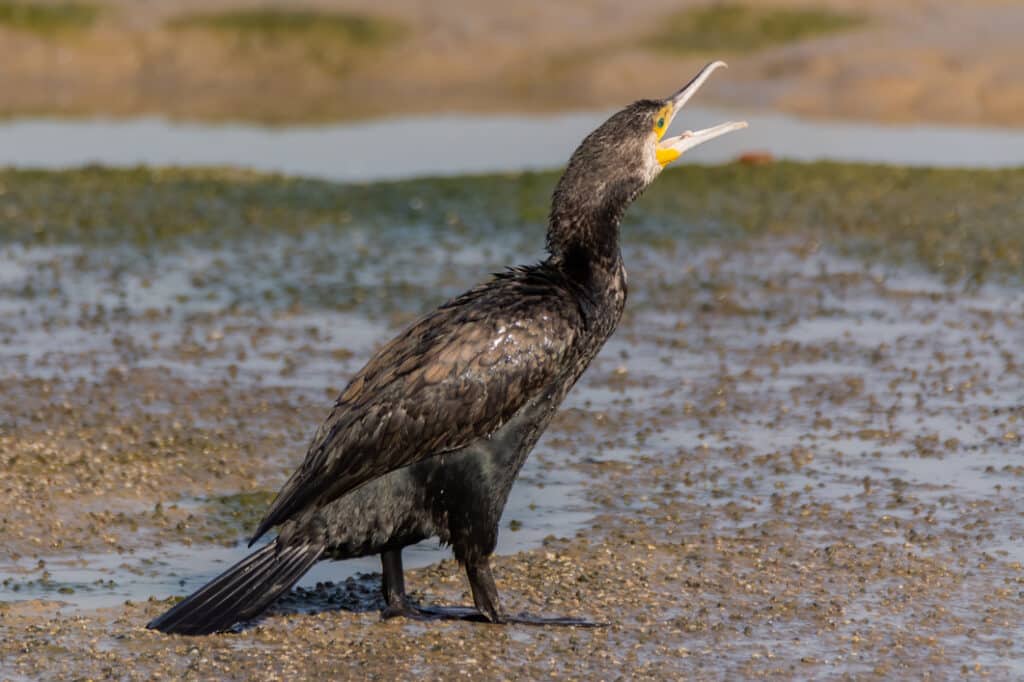Facts about the Great Cormorant
Scientific name: Phalacrocorax carbo
Bird Family: Cormorants and shags
UK conservation status: Green
At a glance
- UK resident and winter visitor still recovering from very low numbers in the 1950-60s.
- Formerly exclusively a coastal breeder in the UK, the first inland colony was established in Essex in 1981.
- Natural England has issued licences to fishery owners to kill more than 11000 Cormorants in the past five years.

A large, mostly black waterbird, the Great Cormorant (or ‘cormorant) is one of 36 species of cormorants and shags worldwide. The majority, including all Northern Hemisphere species, have mainly dark plumage, but some Southern Hemisphere species are black and white and a few quite colourful. Many have areas of coloured skin on the face (especially the gular skin) which typically become more brightly coloured in the breeding season. Their feet are four-toed and webbed, a distinguishing feature among the Pelecaniformes the Order that cormorants belong to.
Cormorants are striking birds, often seen near water bodies standing on bare branches, posts or rocks with their wings held out to dry. The UK’s resident birds are joined in winter by large numbers of cormorants from Europe and while typically an estuarine species they are increasingly being seen inland at reservoirs, lakes and gravel pits.
That has not always been the case though. Historically, cormorant populations both here in the UK and in near-Europe have been kept at a low level due to persecution by fishing interests and through reduced breeding success (in the 1950-60s) as a result of pesticides concentrated in the bodies of fish (the use of DDT severely reduced the Double-crested Cormorant in North America through the same mechanism).

Thankfully through the EU Birds Directive it became illegal in 1979 to disturb, capture, or kill cormorants, or destroy or rob their nests. Legal protection coupled with reduction of water pollution and a ban on many dangerous pesticides helped the cormorant population bounce back across Europe. While the cormorant population has decreased a little in Scotland, and northeast and southwest England, there has been a significant range expansion in England and regions bordering the Irish Sea.
Cormorants are increasingly nesting inland too. Almost exclusively a coastal breeder in the UK, the first inland tree-nesting colony became established in1981 at Abberton reservoir in Essex. Interestingly, this colony was later found to be birds of the continental sub-species P. c. sinensis, triggering a series of identification articles and debates that carry on to this day.
The calls for ‘lethal control’ are not confined to the UK. In October 2022, the European Parliament voted on a report calling for an “EU cormorant management plan”.
Problems with fisheries are usually far more complex than just losing fish to cormorants. The INTERCAFE (Interdisciplinary Initiative to Reduce Pan-European Cormorant-Fisheries Conflicts) research project identified a whole range of reasons why fish production is in decline, including invasive species, climate change, impoverished water quality, pollution, or the increase of algae in waters (aka eutrophication). They clearly state that killing Cormorants won’t change anything – restoring the natural habitats of cormorants and fish, and sustainably managing wetlands will make far more of a difference.
Again echoing the shooting industry’s experience, killing predators of any sort – unless on a monumental scale and for the foreseeable future – simply doesn’t work. If a site has an abundance of fish whatever cormorants that are left in the area will continue to come back and migrants will continue to find them.
